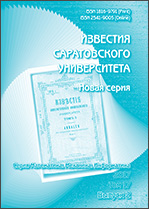|
Scientific Part
Computer Sciences
Classification and recognition of structures of genetic sequences
V. A. Tverdokhlebova, D. A. Kariakinb
a Institute of Precision Mechanics and Control, RAS, 24 Rabochaya St., Saratov 410028, Russia
b Saratov State University, 83 Astrakhanskaya St., Saratov 410012, Russia
Abstract:
For solving problems of determining the relationships between the properties
of organisms and the properties of the corresponding genetic sequences, we proposed a
classification of genetic sequences based on numerical indicators of recurrent and $Z$-recurrent shapes,
which define the structure of functional relationships of elements in sequences.
For numerical indicators of recurrent and $Z$-recurrent shapes, we introduce a method
of classification of genetic sequences. We compared a numerical characteristic that generalizes numerical values
with a numerical characteristic of recurrent or $Z$-recurrent shapes which determine the structure of a sequence for
each sequence of a biological rank considered in the recognition problem,
which has a meaningful interpretation in the application area.
The problem of recognition is considered from two points of view:
when we determine belonging of a sequence to a specific rank of sequences,
and when we determine which group of sequences contains the experimental sequence.
Basic mathematical difficulties in solving these recognition problems are associated with
the search difference in numerical representation of recurrent and $Z$-recurrent
shapes of experimental sequences.
To overcome these difficulties we created a spectrum of numerical indicators
of recurrent and $Z$-recurrent shapes.
Classification and recognition of sequences are illustrated by an example
with three ranks of genetic codes of organisms,
each of them represented by $5$ sequences.
$Z$-recurrent shape is introduced to define and extend the classification of sequences
and increase the efficiency of recognition methods.
Key words:
sequence, genetic sequence, recurrent definition of a sequence, $Z$-recursive definition of a sequence, recurrent shape, $Z$-recurrent shape, classification of sequences, recognition of sequences.
Received: 12.04.2018
Accepted: 22.02.2019
Citation:
V. A. Tverdokhlebov, D. A. Kariakin, “Classification and recognition of structures of genetic sequences”, Izv. Saratov Univ. Math. Mech. Inform., 19:3 (2019), 338–350
Linking options:
https://www.mathnet.ru/eng/isu812 https://www.mathnet.ru/eng/isu/v19/i3/p338
|

| Statistics & downloads: |
| Abstract page: | 141 | | Full-text PDF : | 69 | | References: | 23 |
|




 Contact us:
Contact us: Terms of Use
Terms of Use
 Registration to the website
Registration to the website Logotypes
Logotypes








 Citation in format
Citation in format 